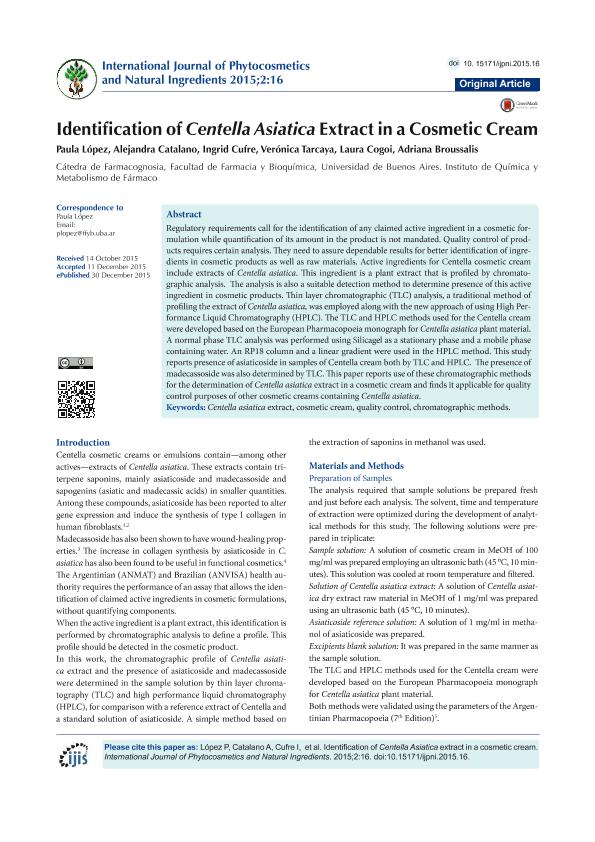Artículo
Identification of Centella asiatica extract in a cosmetic cream
López, Paula Gladys; Catalano, Alejandra Vanina; Cufre, Ingrid Maria; Tarcaya, Veronica Paola; Cogoi, Laura Carolina ; Broussalis, Adriana Maria
; Broussalis, Adriana Maria
 ; Broussalis, Adriana Maria
; Broussalis, Adriana Maria
Fecha de publicación:
10/2015
Editorial:
IJIS Publishing Company
Revista:
International Journal of Phytocosmetics and Natural Ingredients
ISSN:
2374-0639
Idioma:
Inglés
Tipo de recurso:
Artículo publicado
Clasificación temática:
Resumen
Identification of Centella Asiatica Extract in a Cosmetic Cream Short Articles Paula Gladys López 1 * , Alejandra Vanina Catalano 1, Ingrid María Cufre 1, Verónica Paola Tarcaya 1, Laura Carolina Cogoi 1, Adriana María Broussalis 11 Cátedra de Farmacognosia, Facultad de Farmacia y Bioquímica, Universidad de Buenos Aires. Instituto de Química y* Corresponding Author: Junín 956. 2º Piso E-mail: plopez@ffyb.uba.ar Abstract Regulatory requirements call for the identification of any claimed active ingredient in a cosmetic formulation while quantification of its amount in the product is not mandated. Quality control of products requires certain analysis. They need to assure dependable results for better identification of ingredients in cosmetic products as well as raw materials. Active ingredients for Centella cosmetic cream include extracts of Centella asiatica. This ingredient is a plant extract that is profiled by chromatographic analysis. The analysis is also a suitable detection method to determine presence of this active ingredient in cosmetic products. Thin layer chromatographic (TLC) analysis, a traditional method of profiling the extract of Centella asiatica, was employed along with the new approach of using High Performance Liquid Chromatography (HPLC). The TLC and HPLC methods used for the Centella cream were developed based on the European Pharmacopoeia monograph for Centella asiatica plant material. A normal phase TLC analysis was performed using Silicagel as a stationary phase and a mobile phase containing water. An RP18 column and a linear gradient were used in the HPLC method. This study reports presence of asiaticoside in samples of Centella cream both by TLC and HPLC. The presence of madecassoside was also determined by TLC. This paper reports use of these chromatographic methods for the determination of Centella asiatica extract in a cosmetic cream and finds it applicable for quality control purposes of other cosmetic creams containing Centella asiatica.
Archivos asociados
Licencia
Identificadores
Colecciones
Articulos(IQUIMEFA)
Articulos de INST.QUIMICA Y METABOLISMO DEL FARMACO (I)
Articulos de INST.QUIMICA Y METABOLISMO DEL FARMACO (I)
Citación
López, Paula Gladys; Catalano, Alejandra Vanina; Cufre, Ingrid Maria; Tarcaya, Veronica Paola; Cogoi, Laura Carolina; et al.; Identification of Centella asiatica extract in a cosmetic cream; IJIS Publishing Company ; International Journal of Phytocosmetics and Natural Ingredients; 2; 10-2015; 1-3
Compartir
Altmétricas



